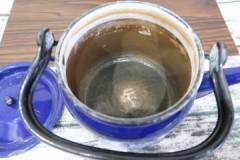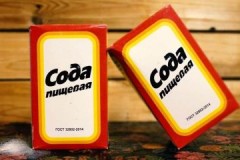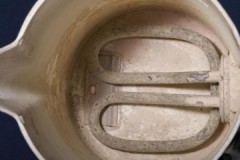Effective ways to remove scale in a stainless steel kettle at home
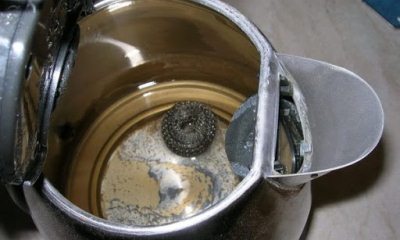 Limescale forms on the inside of any kettle. Stainless steel appliances are no exception.
Limescale forms on the inside of any kettle. Stainless steel appliances are no exception.
Do not leave a thick layer on the walls. It not only impairs the thermal conductivity of the device, but also harms human health, being deposited in the kidneys in the form of stones.
How descale the kettle from stainless steel at home, read the article.
Content
How to get rid of with folk remedies?
You can cope with lime deposits using folk remedies. Some of them are as effective as specialized household chemicals, but they are much cheaper.
Lemon acid
Citric acid is an effective anti-limescale agent.... She is able to cope with even the most chronic layer. Depending on the thickness of the deposit, take from 10 to 20 g of powder per 1 liter of water.
Then it is washed and boiled with clean water, but they do not drink it, but drain it to get rid of the remnants of the lemon. Read more here.
The video will tell you how to get rid of scale in a stainless steel kettle:
Vinegar
The second most popular anti-scale remedy is vinegar. To remove old plaque, use the essence (2-3 teaspoons per 3 liters of water). If the scale is insignificant, they manage with table vinegar (50 ml per 3 liters of water).
The product is poured into a kettle and brought to a boil. After an hour, the solution is drained, the device is washed and boiled with clean water... Read more about descaling a kettle using vinegar. here.
The main disadvantage of vinegar is its pungent odor, so the procedure should be carried out in a well-ventilated area.
How to descale a kettle using vinegar, video instruction:
Soda
To remove salt deposits, 3 liters of water are poured into the kettle and 6 heaped teaspoons of soda are poured. Then the solution is boiled and left for 2 hours. Then thoroughly clean the device with a sponge and rinse with water.
Soda is able to soften and remove only a thin layer of deposits... Therefore, it is advisable to use it for preventive or superficial cleaning. Details - in this article.
Coca-Cola, Fanta, Sprite
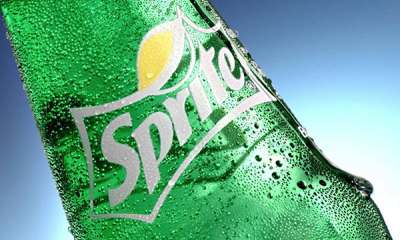 These carbonated drinks contain phosphoric acid, which dissolves limescale quickly and without a trace.
These carbonated drinks contain phosphoric acid, which dissolves limescale quickly and without a trace.
For the procedure, the kettle is half filled with a drink and brought to a boil. When the liquid has cooled, the walls are cleaned with a brush, after which the device is thoroughly rinsed with clean water.
Since Coca-Cola and Fanta contain dyes, it is not recommended to use them to remove scale from plastic appliances. In this case, it is better to use Sprite. Read more about descaling with Coca-Cola in this article.
Oxalic acid
You can deal with plaque with oxalic acid. It acts like a lemon. To remove limescale deposits, you will need 10 g of powder for every liter of water.
When the solution boils, the gas is turned off and waited for it to cool down... You need to withstand the acid in the kettle for at least 2-3 hours.
When the liquid has cooled, it is drained. This method cannot be called effective. It is more suitable for the prevention of salt deposition.
Apple and potato peels
Apple and potato peelings contain fruit acids that can help fight scale.
The procedure is as follows:
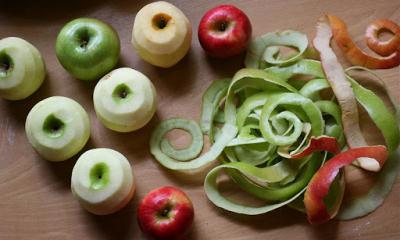 a clean peel without traces of earth is placed in a kettle and poured with water;
a clean peel without traces of earth is placed in a kettle and poured with water;- bring it to a boil;
- leave for 2-3 hours;
- carefully rub the walls with the hard side of the sponge and a cleaning agent;
- rinse the kettle with clean water.
If you make some effort, you can even cope with an old layer of scale, but for this, the procedure must be carried out at least 3 times. This method is good because it doesn't cost a dime, since the peel would still go to the trash can.
Cucumber or tomato pickle
The brine left over from pickles or tomatoes does not need to be rushed down the toilet. It can be used to descale your kettle.
The procedure is as follows:
- Pour the brine into the kettle. It must completely cover the scale layer. If it is not enough, you can add a little water.
- Bring the liquid to a boil.
- Leave on for 2-3 hours.
- Rinse the kettle with water several times, then boil and drain the liquid.
How to remove household chemicals?
On sale you can find professional scale cleaners. There are formulations designed specifically for dummies. The following tools are popular:
 Anti-scale. It is produced in the form of a powder, packaged in small bags weighing 100 g. 1 package is required for descaling. The powder is poured into a kettle, filled with water, boiled and left for 2-3 hours. Then the appliance is washed thoroughly. The cost of 1 package is about 15 rubles.
Anti-scale. It is produced in the form of a powder, packaged in small bags weighing 100 g. 1 package is required for descaling. The powder is poured into a kettle, filled with water, boiled and left for 2-3 hours. Then the appliance is washed thoroughly. The cost of 1 package is about 15 rubles.- Topper. Liquid is used to remove scale. It is bottled in 250 ml plastic bottles. For 1 liter of water, take 120 ml of the cleaning composition. The solution is heated to 50 degrees and left for 30 minutes. The cost of 1 bottle is 150 rubles.
- SonixBio, descaler. 1 liter of water is poured into the kettle, 100 ml of cleaner is added. The composition is heated to 50 degrees, after 30 minutes the solution is poured out, the container is thoroughly rinsed and boiled. Price for 250 ml - 140 rubles.
The products can be purchased in a store, in the department with household chemicals, or ordered online.
Prevention of limescale formation
So that the stainless steel is not covered with a thick layer of limescale, you need to adhere to the following recommendations:
- do not leave water inside;
- use soft filtered or bottled water for the kettle;
- regularly clean the inside of the device with baking soda and a sponge;
- Carry out preventive treatment at least 1 time per month, for this use "light" means, for example, potato peelings.
Helpful information
A stainless steel kettle is a durable device, but if not properly maintained, it can even be damaged. To prevent this from happening, you need to adhere to the following recommendations:
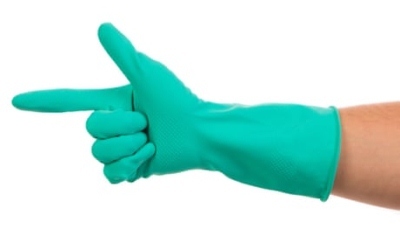 Do not use a hard metal brush to remove limescale. Do not use a knife or other sharp implements to scrape off limescale deposits.
Do not use a hard metal brush to remove limescale. Do not use a knife or other sharp implements to scrape off limescale deposits.- When using professional cleaners, strictly follow the instructions. Do not leave them in the appliance for longer than indicated on the packaging.
- Do not try to remove limescale with corrosive acids.
After finishing the processing, it is imperative to boil the kettle using clean water. You can't drink it. The first liquid must be drained.
You will find a lot of useful information about descaling here.
Conclusion
You can remove scale in a stainless steel kettle with the help of available tools. The most effective are citric acid, carbonated drinks and cucumber pickle. If lime deposits are old, store cleaners come to the rescue.

